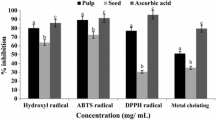Abstract
The present study embodies investigations on the chemical composition of three types of carob fruits viz. sisam, fleshy and wild. A perusal of analytical and chromatographic results reveals that the pods of sisam type are rich in sugar content (43.84%) as compared to that of wild and fleshy types. The sugars in general are of non-reducing type. The pods contain four kinds of sugars, namely: glucose, fructose, maltose and sucrose; latter being the principal constituent. In comparison with sugar content the protein content of pods is very low being 2.48%–4.76%. There are four types of amino acids present in the pods, namely: alanine, proline, leucine and valine. The fruits are very poor in fats. As compared to the pods, seeds in general lack sugars but possess higher protein, fat and ash content.
Zusammenfassung
In der Arbeit wurden drei Typen — ‘Sisam’, fleischig und wild — der Bohne ‘Ceratonia siliqua’ untersucht.
Wie aus den analytischen und chromatographischen Ergebnissen zu ersehen ist, sind die Früchte des ‘Sisamtyps’ reicher an Zucker als die wilden und fleischigen Typen. Der maximale Zuckergehalt betrug bei der ‘Sisamart’ 43,48%. Es wurde festgestellt, daß der Zuckergehalt sich aus Glucose, Fructose, Maltose und Saccharose zusammensetzt, von denen die Saccharose den Hauptbestandteil bildet.
Im Vergleich zum Zuckergehalt ist der Proteingehalt sehr niedrig, er schwankt zwischen 2,48 und 4,76%. Vier Aminosäuren konnten nachgewiesen werden, und zwar Alanin, Prolin, Leucin und Valin. Die Früchte sind arm an Ölen. Im Vergleich zu den Fruchtschalen sind die Samen sehr arm an Zuckern, besitzen aber einen höheren Protein-, Fett- und Aschegehalt.
Résumé
Le but de cet étude est d'analyser la nature chimique des fruits de caroubier des types sisam, pulpeux et sauvage. Comme on le constate dans les résultats analytiques et chromatographiques, les fruits de type sisam sont plus riches en protéin que de type pulpeux et la quantité de protéin y atteint à 43.48%. Les sucres sont en général de nature non réduits. Les légumines contiennent 4 types de sucre: glucose, fructose, maltose et saccarose. Entre eux c'est le saccarose qui est le plus abondant. Dans les légumines la quantité de protéin est moins que de la quantité de sucre, on a constaté que cette quantité varie de 2.48% à 4.76%. Les légumines peuvent comporter 4 types d'acide aminé: alanine, proline, leucine et valine. Les fruits sont très pauvres en huile. Les résultats d'analyse des germes ont découvert l'absence de sucre. Pourtant les germes sont riches, d'après ces analyses, en protéin, huile ainsi qu'en cendre.
Similar content being viewed by others
References
Charalambous, J. & Papaconstantinou, J. (1966). Current results on the chemical composition of the carob bean. Cyprus Agricultural Research Institute.
Kaufmann, H. P. (1958). Analyse der Fette und Fettprodukte. Springer-Verlag.
Loomis, W. E. & Shull, C. A. (1937). Methods in Plant Physiology. pp. 267. McGraw-Hill Book Co., New York.
Author information
Authors and Affiliations
Additional information
Authors are greatly indebted to Tate and Lyle Limited, Research Centre, Kent, England, for the financial support of this project.
Rights and permissions
About this article
Cite this article
Vardar, Y., Seçmen, Ö. & Ahmed, M. Preliminary results on the chemical composition of the Turkish carob beans. Plant Food Hum Nutr 21, 367–379 (1972). https://doi.org/10.1007/BF01099604
Issue Date:
DOI: https://doi.org/10.1007/BF01099604




